
Sea State
The US Navy’s newest destroyer, the USS Zumwalt, began the long voyage to its home port of San Diego last week. Its first stop was Newport, Rhode Island, where visitors were given a tour of the futuristic destroyer’s bridge, mission centre and armament. The destroyer will visit several other ports along the way—including a stop in Baltimore on 15 October—where it’ll be formally commissioned into the USN during Fleet Week. USS Zumwalt is the USN’s largest destroyer to date and has been plagued by cost and technical issues. The vessel, which boasts a stealthy design that makes it look like a cross between the USS Monitor and the Starship Enterprise (yes, that one), is helmed by Captain James Kirk. How fitting.
In other news from across the Pacific, NATO warships have gathered in Halifax, Canada this week for a 13-day anti-submarine warfare exercise dubbed Cutlass Fury. Canada’s largest anti-submarine warfare exercise in 20 years also includes vessels from the US, France, Germany, Spain and the UK. It comes at a time when concern about Russia’s resurgent submarine operations has been ratcheted up.
Flight Path
Adding to the latest series of close encounters, last week a Russian fighter jet flew within 10 feet of a USN P-8 Poseidon during four intercepts over the Black Sea. According to a Pentagon spokesperson, the ‘unsafe intercept’ by the Russian SU-27 Flanker fighter took place while the USN aircraft was conducting routine operations in international airspace. Earlier this year, Russian jets buzzed the USS Donald Cook in the Baltic Sea, coming within 30 feet of the warship.
The QF-4 full-scale aerial target drone conducted its final unmanned mission in late August, as part of the final chapter of the F-4’s 50-year history of service with the US. But the QF-4, which is set to be replaced by the QF-16, didn’t go down without a fight. See why the F-4 made the top five all-time fighter list in this Strategist piece.
In F-35 news, Australia’s Defence Industry Minister, Christopher Pyne, will meet with the F-35 Joint Program Office in the US in October to discuss turning Australia into a maintenance and sustainment hub for Joint Strike Fighter operations. And finally, for an interesting read on the heavy price tag and criticism of the world’s most hi-tech helmet developed for F-35 pilots, check out this piece by The Economist (paywalled).
Rapid Fire
The US and India will conduct a joint military exercise from 14–27 September in Uttarakhand, on India’s northern border with China. The exercise is the latest in a series of measures aimed at strengthening US–India defence relations. In April, the two countries signed a Logistics Exchange Memorandum of Agreement, followed last month by an agreement on the provision of military logistics services.
Australian scientists are working on the creation of dynamic camouflage for military vehicles. The ‘chameleon tanks’ are fitted with polycarbonate cells that change colour to blend in with new surroundings. The colour can be changed on demand by switching a small voltage across the cell. The technology was trialled this year at ADF’s Cultana training site in South Australia.
BAE Systems showcased its bid for Land 400 Phase 3 at last week’s Land Forces 2016 Exposition held in Adelaide. The infantry fighting vehicle (IFV) CV90 is an attractive option for Australia, with nine different variants in service and an impressive pedigree of successful engagement in UN and NATO missions worldwide. Rheinmetall have entered a competing bid with its Lynx IFV, presented at Eurosatory 2016 in June (see it here).
Zero Gravity
NASA is probing things again. In collaboration with Canada, France, Germany, Italy and the UK, it has launched the OSIRIS-REx to hunt down the carbonaceous asteroid 101955 Bennu. Bennu is an ancient asteroid that’s supposed to have formed around the birth of our solar system. NASA aims for OSIRIS-REx to rendezvous with the asteroid in 2018, probe its depths and return in 2023 with samples from the surface.
China’s new space lab—Tiangong-2—is scheduled to launch this week from the northwest city of Jiuqun. The 20,000 kilogram module can hold three crew members and will be propelled into space by a Longmarch 2-F rocket. The space lab is designed to test China’s ability to transport goods into space, and to conduct large-scale scientific experiments, such as studying gamma ray bursts building on the planned Franco-Chinese SVOM missions.
Manned space missions only started 65 years ago, and already it appears us humans might be out of a job. Former NASA researcher Dr Phil Metzger has detailed a plan for a ‘Self-sufficient Replicating Space Industry’. The three-stage plan involves sending 12 tons of robots and manufacturing gear to the moon. The robots would mine resources and build up to 150 tons of infrastructure and equipment independently. Dr Metzger says the plan could provide a platform to support a variety of space industries at a fraction of the cost of using manned missions.

